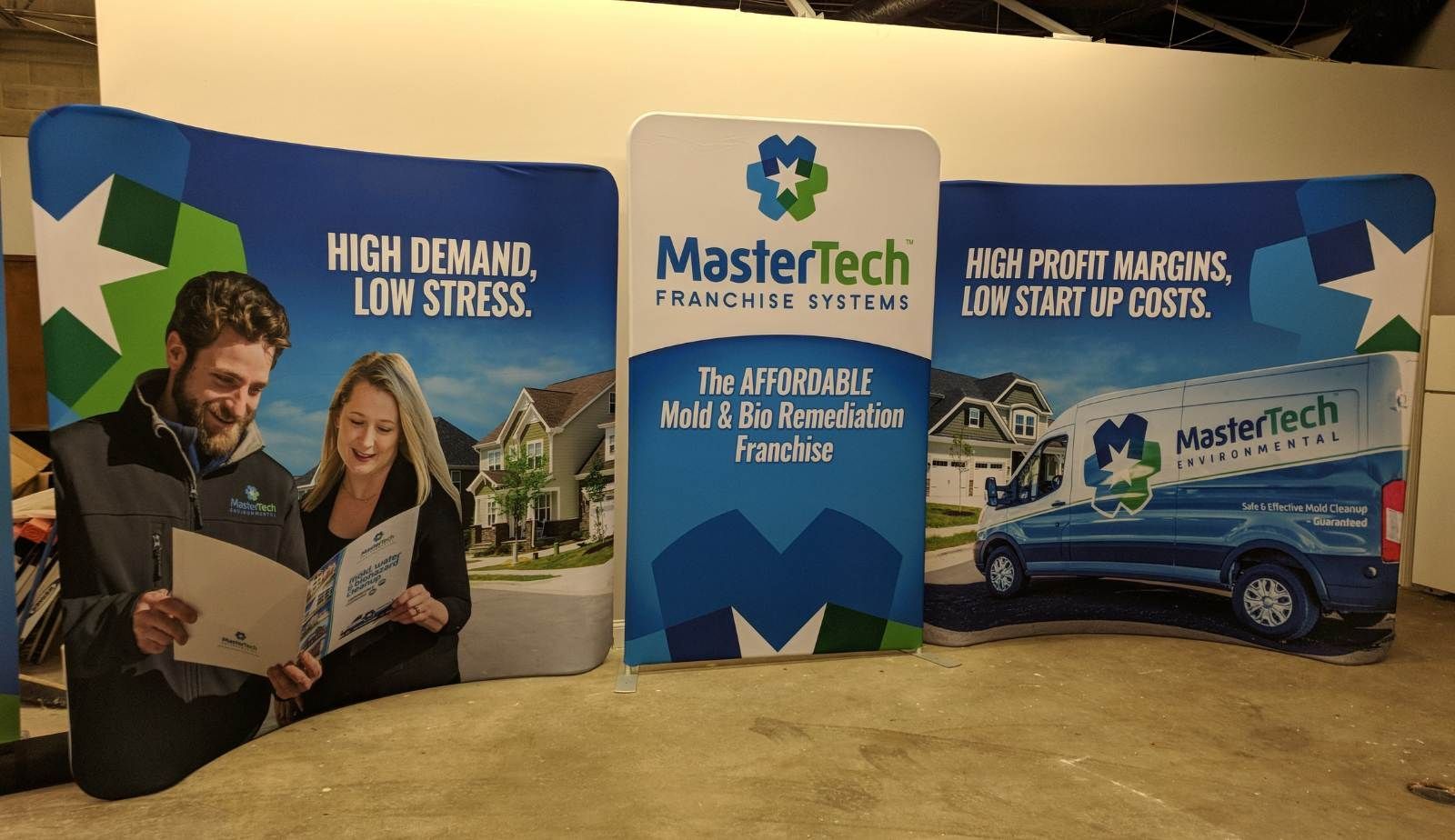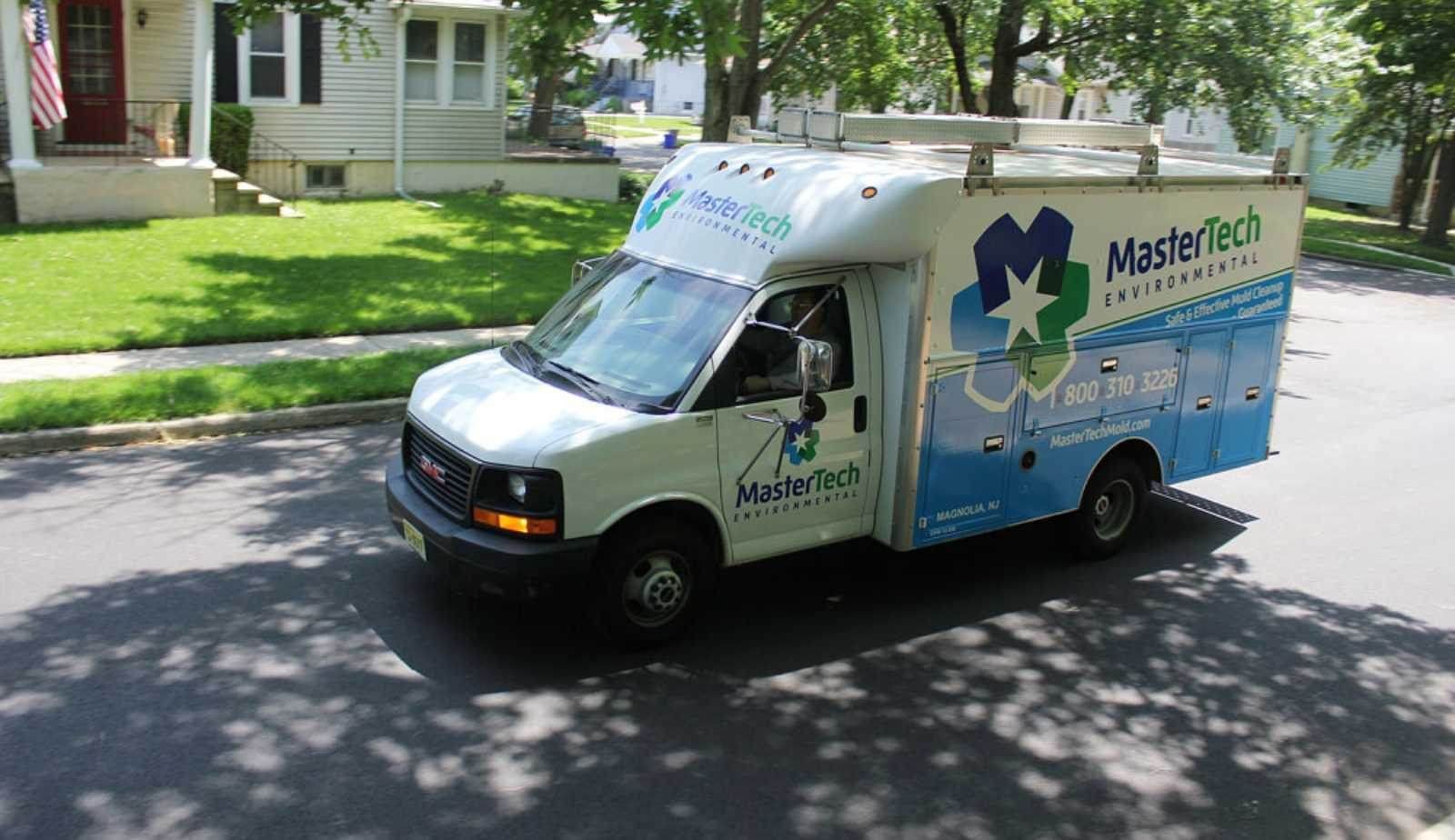Mastertech Franchise Blog

Aspiring entrepreneurs contemplating a career in the restoration industry often face a critical decision: launch their own business or step into a franchise model. Among the various options available, Mastertech Environmental stands out as a more stable and resourceful choice than starting from scratch, thanks to its proven systems and support structure . This franchise not only minimizes startup risks but also provides essential training and marketing resources that are pivotal for success in this competitive landscape. Investing in a Mastertech Environmental franchise means tapping into a robust business model that thrives on consistent demand for services like mold remediation and water damage restoration. Owners benefit from a established brand reputation , allowing them to focus on delivering quality service rather than building recognition from the ground up. Furthermore, the recession-resistant nature of these essential services ensures a reliable income stream, regardless of economic fluctuations. With environmental challenges on the rise, choosing to partner with an established franchise like Mastertech Environmental offers the dual advantage of financial opportunity and a meaningful mission. This makes it not just a business endeavor, but a chance to make a tangible difference in communities while securing a solid return on investment. Core Differences: Mastertech Environmental vs Starting a Restoration Business from Scratch When considering a venture in restoration services, the choice between joining Mastertech Environmental and starting from scratch presents significant differences. Key elements include brand establishment, risk factors, and operational efficiencies. Established Brand Benefits Choosing Mastertech Environmental provides immediate access to an established brand. The franchise network is already recognized for its credibility and reliability in the restoration industry. Franchisees benefit from: Customer Trust: Established brands often have customer loyalty and recognition that new businesses lack. Marketing Support: Franchisees receive comprehensive marketing resources that facilitate business growth. Training Programs: Mastertech offers extensive training , empowering new owners with the necessary skills to perform various restoration services competently. These aspects significantly enhance a franchisee's ability to generate leads compared to a startup that must build a reputation from the ground up. Risk and Investment Comparison Starting a restoration business involves considerable financial risk. Entrepreneurs need to invest in tools, marketing, and licenses without the assurance of immediate return. In contrast, investing in a Mastertech Environmental franchise generally entails: Lower Initial Risk: Franchisees benefit from a proven business model that minimizes the uncertainties associated with startups. Expected ROI: Established franchises often have historical data that indicate potential earnings, offering a clearer picture of expected returns. Supported Investment: Mastertech provides guidance on financial management and business practices, decreasing the chances of costly mistakes typically made by new entrepreneurs. The difference in risk is palpable and points to a more stable option in a franchise. Business Model Efficiency Mastertech Environmental operates on a tested business model designed for efficiency. This model allows franchisees to utilize systems that have been refined over time. Key features include: Turnkey Solutions: Franchisees receive operational frameworks that streamline processes from job acquisition to completion. Access to Resources: A well-established supply chain ensures franchisees have the necessary tools and materials readily available, reducing delays. Supportive Network: Being part of a franchise network allows franchisees to share experiences and best practices, further enhancing operational efficiency. Starting a restoration business independently requires developing all these components from scratch, which can lead to inefficiencies and slower growth.

In the rapidly expanding mold and water damage restoration industry, Mastertech franchise owners are positioned for remarkable success. With increasing awareness of health risks associated with mold and the growing frequency of water-related incidents, the demand for professional remediation services is on the rise. Mastertech franchise owners leverage comprehensive training, strong brand recognition, and ongoing support to efficiently tackle these challenges and drive their businesses forward. Franchisees benefit from a proven business model that not only simplifies the initial setup but also provides guidance through the complexities of the industry. By investing in the best practices and tools for mold remediation and water damage restoration, they ensure high-quality service delivery. Furthermore, the collaborative franchise environment fosters shared learning and problem-solving among owners, enhancing their overall growth potential. The commitment to excellent customer service and operational excellence sets Mastertech franchise owners apart from competitors. By focusing on community needs and building strong relationships, they secure a loyal customer base. This strategic approach positions them for sustained growth in a market that continues to evolve. The Mastertech Franchise Systems Model Mastertech Franchise Systems provides a structured approach for franchise owners to thrive in the mold and water damage restoration industry. This model encompasses a comprehensive range of services, robust training programs, and strong brand positioning to support franchisee success. Service Offerings Overview Mastertech Franchise Systems specializes in a diverse set of restoration services. These services include: Mold Remediation: Comprehensive mold inspection and removal techniques. Water Damage Restoration: Solutions for both minor leaks and significant flooding incidents. Biohazard Cleanup: Professional cleaning services for trauma scenes and hazardous materials. Hoarding Cleanup: Specialized techniques to restore cluttered environments. Each service line operates with high profit margins, enabling franchise owners to tap into multiple revenue streams. This versatility ensures that franchisees can address various customer needs within the expanding environmental services market. Training and Support Structure Training and ongoing support are integral to the Mastertech Franchise model. New franchisees undergo extensive initial training covering key areas: Technical Skills: Mold inspection protocols and restoration techniques. Safety Procedures: Ensuring compliance with industry regulations. Business Development: Strategies for client acquisition and service delivery. Franchise owners have access to continuous support through quarterly business reviews and marketing assistance. This structured training cultivates a knowledgeable workforce equipped to handle various restoration challenges effectively, providing them with a competitive edge. Brand Reputation and Market Positioning Mastertech Franchise Systems enjoys a strong brand reputation in the restoration industry. Its established presence enhances franchisee success. Key elements include: Brand Recognition: Consistent branding fosters trust and credibility among customers. Digital Marketing Support: Comprehensive online strategies improve visibility and client acquisition. Collaborative Network: Franchisees benefit from a community that shares best practices and resources. This strategic market positioning enables franchise owners to compete effectively, leveraging the Mastertech name to attract clients seeking reliable restoration services. Effective marketing enhances local efforts and expands reach within the community, solidifying Mastertech's status as a leader in the mold and water damage restoration sector.

Joining the Mastertech Environmental family transcends the traditional concept of purchasing a franchise. It embodies a commitment to a culture characterized by trust, mentorship, and a shared purpose. Franchisees become part of a collaborative network, where owners enjoy substantial peer support , fostering an environment that promotes collective success and personal growth. In this unique ecosystem, members can tap into proven operational systems without the limitations of corporate red tape, allowing them to maintain their entrepreneurial spirit while benefiting from established best practices. This combination of collaboration and efficiency significantly enhances the capacity to restore homes and lives, creating a meaningful impact in their communities. The shared mission to restore homes and lives drives a sense of purpose among franchisees, aligning personal ambitions with a greater cause. This alignment not only enriches the franchise experience but also bolsters customer engagement, as franchisees advocate for the highest quality of service in environmental remediation. A Culture Built on Trust and Purpose Mastertech Environmental fosters a culture deeply rooted in trust and a shared purpose . This environment enables franchisees to reach their full potential while significantly impacting the communities they serve. By promoting collaboration and mentorship, Mastertech creates a supportive network that prioritizes both business success and personal fulfillment. Shared Commitment to Restoring Lives Franchisees at Mastertech Environmental unite under a common goal: to restore not only homes but also lives. The restoration industry presents unique challenges, often involving sensitive situations such as mold, water damage, and biohazard cleanup. Franchise owners understand the importance of their work in protecting people’s health and safety. This mission instills a strong sense of responsibility and pride among franchisees. They are trained to approach each situation with empathy and professionalism, ensuring that clients feel supported during tough times. By embracing a client-focused strategy, Mastertech encourages continuous training and shared experiences. This dedication to improving lives underpins every aspect of their operations, creating positive outcomes for both clients and franchise owners. Mission-Driven Community The community within Mastertech Environmental is grounded in mission-driven principles that highlight integrity and accountability. Each franchisee is not just an owner but a vital part of a larger movement to elevate standards in the restoration industry. Peer support is pivotal in this culture. Franchisees share insights and strategies, benefiting from the collective knowledge of the network. Regular meetings and training sessions promote collaboration and help maintain high service standards. Furthermore, franchisees partake in community outreach programs that resonate with their mission. This engagement builds trust within neighborhoods while supporting individuals impacted by restoration needs. By aligning their goals with a higher purpose, franchisees contribute to a sustainable, impactful business that truly makes a difference. Collaboration and Peer Support Among Franchisees Within the Mastertech Environmental family, collaboration and peer support are integral to the success of franchisees. This supportive network fosters entrepreneurial growth through shared resources, experiences, and mentorship opportunities that enhance business outcomes. Peer Networking and Owner Collaboration Franchisees in the Mastertech Environmental network benefit from robust peer networking opportunities. They participate in regular meetings and events aimed at fostering collaboration among owners. These gatherings serve as platforms for sharing challenges, solutions, and growth strategies. Franchisees are encouraged to form lasting connections, enabling them to draw on the collective knowledge and experiences of their peers. This collaborative environment leads to innovative solutions and improved operational efficiencies. Franchisees can also engage in joint marketing efforts and community outreach, amplifying their impact. Mentorship Within the Mastertech Network Mentorship is a cornerstone of the Mastertech experience. New franchisees are paired with experienced members who provide guidance and support throughout the startup phase and beyond. This one-on-one mentorship helps newcomers navigate the complexities of running an environmental service business. Mentors share best practices, operational insights, and industry knowledge that can significantly accelerate growth. This structured mentorship fosters a culture of learning and ensures that all franchisees have access to the tools necessary for success. Additionally, it builds lasting relationships rooted in trust and mutual support. Knowledge Sharing for Success The Mastertech franchise network prioritizes knowledge sharing as a vital mechanism for achieving collective success. Franchisees gain access to an extensive repository of resources, including training programs, webinars, and collaborative workshops. These resources are instrumental in keeping franchisees updated on industry trends, regulations, and new technologies. Members actively participate in forums and discussion groups, exchanging valuable insights and strategies that enhance operational practices. This culture of openness encourages continuous improvement, ensuring every franchisee can leverage the collective intelligence of the network to achieve their business objectives.

Many individuals seek opportunities that go beyond just earning a living; they desire to make a meaningful impact in their communities. The Mastertech Environmental franchise provides just that, offering franchise owners a chance to assist families during some of their most challenging moments. By specializing in services like mold remediation, water damage restoration, fire damage cleanup, hoarding assistance, and biohazard cleanup, franchisees play a crucial role in restoring both properties and lives. Owning a Mastertech franchise means being part of a high-demand industry that not only promises financial rewards but also provides the satisfaction of helping people recover from life's worst messes. This unique franchise model allows owners to operate with minimal overhead while enjoying the support of a trusted brand known for its integrity and effectiveness in the environmental services sector. As more homeowners and businesses face these challenging situations, the need for reliable restoration services continues to grow. Investing in a Mastertech franchise not only taps into a recession-resistant market but also offers the opportunity to build a legacy of support and recovery within the community. What Is Mastertech Franchise? Mastertech Franchise represents a unique opportunity in the environmental services sector, focusing on essential services that aid families during difficult times. This franchise is dedicated to providing professional and compassionate cleanup solutions across various scenarios, from mold remediation to biohazard cleanup. Company Overview Mastertech Franchise Systems, founded in 2016 by Tom Duff, is based in Mount Arlington, New Jersey. The company specializes in environmental services, offering franchise opportunities that empower entrepreneurs to start their own businesses in this high-demand sector. With a model designed for success, Mastertech thrives in markets requiring timely and competent environmental cleanup. The franchise began operating right after its establishment, emphasizing rapid growth and the ability to effectively respond to community needs. Core Values and Mission Mastertech places a strong emphasis on integrity, compassion, and excellence. The company is committed to maintaining high standards in service delivery, ensuring that each franchise owner aligns with these core values. The mission of Mastertech encompasses not merely the provision of cleanup services but also the goal of helping families navigate challenging experiences efficiently. By prioritizing customer care and professionalism, Mastertech instills confidence in its clients as they face tough situations. Types of Services Offered Mastertech provides a diverse suite of services, including: Mold Remediation: Efficient removal of mold to prevent health risks. Water Damage Restoration: Immediate response for water-related emergencies, including flooding and leaks. Fire Damage Cleanup: Comprehensive restoration services after fire incidents. Hoarding Cleanup: Sensitive and supportive assistance for families dealing with hoarding situations. Biohazard Cleanup: Safe handling and disposal of hazardous materials. These services are essential in aiding clients through stressful circumstances, making Mastertech a valuable resource in the environmental services community. Franchise owners receive training and support, equipping them with the tools needed to deliver these critical services effectively. Key Revenue Streams and Services Mastertech Environmental franchise owners provide critical services that address significant challenges faced by families and businesses. The diverse offerings create multiple revenue streams while ensuring comprehensive support for clients dealing with difficult situations. Mold Remediation and Mold Inspections Mold remediation is a cornerstone service for Mastertech franchises. It involves the process of identifying, removing, and preventing mold growth in residential and commercial properties. The franchise utilizes advanced techniques such as HEPA vacuuming and antimicrobial treatments to ensure thorough removal. Mold inspections play a vital role in this service. Comprehensive mold assessments help identify moisture issues and potential mold sources. By providing detailed reports , franchise owners can effectively inform clients of necessary remediation steps. Continued follow-ups for air quality assessments also reinforce safety, creating ongoing revenue opportunities. Water and Fire Damage Restoration Water and fire damage restoration services represent another significant revenue stream. Mastertech franchises respond promptly to emergencies, helping clients recover from incidents such as flooding or fire. These services include water extraction, drying, and structural repairs. For fire damage, the process involves soot removal and odor mitigation. Quick restoration minimizes further damage and reduces costs for clients. Franchise owners often offer consulting services to assess damages and recommend the best restoration approaches. This proactive engagement can lead to return business and referrals. Hoarding Cleanup Solutions Hoarding cleanup is a sensitive service that requires a compassionate approach. Mastertech franchise owners work closely with clients to address complex situations. The process involves assessing the living space and formulating a tailored cleanup plan . Franchises employ specialized techniques such as HEPA vacuuming and sorting assistance to ensure effective cleanup. This service not only improves living conditions but also supports the mental well-being of clients. By handling hoarding cases carefully, franchise owners establish trust and encourage ongoing support. Biohazard and Trauma Cleanup Biohazard and trauma cleanup services are critical in situations involving hazardous materials or traumatic events. Mastertech franchises are equipped to handle cleanup in areas such as crime scenes or hazardous spills. The process includes ensuring compliance with safety regulations, removing contaminants, and decontaminating affected areas. Franchise owners use specialized equipment and training to provide safe and effective cleanup. This service tends to have significant profit margins due to its specialized nature and strong demand. Franchise owners consistently deliver high-quality biohazard cleanup, reinforcing their reputation in the industry. Each service highlights their commitment to public safety and emotional support for affected families.

Mastertech Franchise Systems offers a structured path into the restoration industry with a model designed for both experienced operators and first-time entrepreneurs. The franchise specializes in essential services such as mold remediation, water damage restoration, biohazard cleanup, and hoarding cleanup—industries that remain in demand regardless of economic cycles. This makes the Mastertech Environmental franchise a recession-resistant business opportunity with a scalable model and low overhead requirements. Franchisees gain access to proven systems, comprehensive training, and turnkey marketing support that simplify the process of starting and growing a restoration business. Protected territories across the USA, including opportunities like Mastertech Environmental of Orange County, provide franchise owners with defined markets and brand credibility from day one. With done-for-you lead generation and ongoing operational support, franchisees can focus on building client relationships and expanding their service offerings. What sets this franchise apart is its accessibility. No prior industry experience is required, and the franchise system equips owners with the tools and processes needed to deliver professional results. From structured training to established branding, entrepreneurs step into a business model that balances independence with support, creating a strong foundation for long-term success. Overview of Mastertech Franchise Systems Mastertech Franchise Systems operates in the environmental services sector with a focus on essential restoration work. The franchise combines a structured business model, strong brand recognition, and comprehensive support to help entrepreneurs enter the industry without requiring prior technical experience. Company History and Reputation Mastertech Franchise Systems was founded in 2016 by Tom Duff in Mount Arlington, New Jersey. From the start, the company positioned itself in the restoration industry by offering services such as mold remediation , water damage repair, hoarding cleanup, and biohazard remediation. The franchise quickly gained recognition for its operational systems and training programs. By providing a proven model , it allowed franchisees to avoid the challenges of building a business from scratch. Its reputation has been built on consistent service quality and customer trust. Franchisees benefit from this established credibility, which helps them attract clients in competitive local markets. The company’s emphasis on compliance with industry standards further strengthens its standing among both customers and partners. Mission and Core Values Mastertech’s mission centers on delivering reliable environmental restoration services that protect health, safety, and property. The company emphasizes professionalism, integrity, and accountability as guiding principles for all franchise operations. Franchisees are encouraged to adopt a client-focused approach. This means prioritizing clear communication, respectful service, and adherence to safety protocols during every project. These values are reinforced through ongoing training and operational support. A strong commitment to ethical practices also defines the franchise system. Mastertech promotes transparency in pricing, responsible handling of hazardous materials, and sensitivity in situations such as hoarding or trauma cleanup. This value-driven approach helps build long-term customer trust. National Presence and Brand Strength Since beginning franchising in 2016, Mastertech has expanded across the United States with protected territories that give franchisees exclusive rights in their regions. This protection reduces internal competition and allows owners to focus on building strong local customer bases. The brand is recognized nationally for its specialized services in mold, water, biohazard, and hoarding cleanup. Its reputation for quality has made it a trusted name in the restoration industry. Franchisees also benefit from turnkey marketing systems and done-for-you lead generation that leverage the brand’s established credibility. Combined with consistent training and operational guidance, this national presence strengthens each location’s ability to compete effectively in both residential and commercial markets. Essential Services Offered Mastertech Environmental franchises deliver specialized cleanup and restoration solutions that address health risks, property damage, and regulatory requirements. These services are structured to meet both residential and commercial needs while maintaining a consistent standard of safety and professionalism. Mold Remediation and Inspection Mold remediation begins with a comprehensive inspection to identify hidden growth, moisture sources, and the extent of contamination. Certified technicians use testing methods and moisture mapping to create a clear remediation plan. The removal process follows strict safety protocols to contain spores, remove affected materials, and apply antimicrobial treatments. This reduces the risk of recurrence and protects indoor air quality. Franchisees also provide a mold-free warranty, which reassures property owners that the job was completed correctly. Regular inspections and preventive recommendations, such as dehumidifier use or duct cleaning, help clients avoid future issues. Mold services are in steady demand because untreated growth can damage structures and trigger respiratory concerns. This makes mold remediation a cornerstone of the franchise model. Water Damage Restoration Water damage cleanup often requires 24/7 emergency response to limit structural deterioration and prevent secondary problems like mold. Technicians handle water extraction, drying, and dehumidification using commercial-grade equipment. Services typically include sewage cleanup, flood restoration, and mitigation of plumbing-related leaks. Teams also coordinate with insurance providers to streamline claims, which helps property owners manage costs. Fire-related water damage is another area of focus, as suppression efforts often leave behind standing water and moisture. By addressing both visible and hidden damage, restoration crews reduce long-term repair needs. Because water intrusion can escalate quickly, this service remains one of the most time-sensitive and essential offerings in the system. Biohazard and Trauma Cleanup Biohazard cleanup covers sensitive situations such as trauma scenes, unattended deaths, and hoarding conditions. Trained professionals follow state and federal regulations for handling and disposing of hazardous materials, including bloodborne pathogens. The process involves disinfecting affected areas, removing contaminated items, and restoring the property to a safe condition. Crews use protective gear and specialized cleaning agents to reduce health risks. In hoarding cases, services extend to sorting, removal, and sanitization while maintaining discretion and respect for occupants. This approach balances technical cleanup with compassion for families. By offering trauma and biohazard cleanup, the franchise provides communities with services that few industries are equipped to handle safely and legally. Unique Advantages of the Mastertech Environmental Franchise Mastertech Environmental offers a franchise opportunity that combines stability, efficiency, and growth potential. It provides essential restoration and remediation services, operates with a lean structure , and generates income from several service lines. Recession-Resistant and Essential Services Mastertech Environmental focuses on services people and businesses cannot ignore, such as mold remediation, water damage restoration, biohazard cleanup, and hoarding cleanup . These needs arise regardless of economic conditions, making the franchise less vulnerable to downturns. Property owners must address these issues quickly to protect health, safety, and property value. This creates a steady demand for professional help, giving franchisees a reliable customer base. The franchise positions itself as a provider of non-discretionary services . Unlike luxury or elective industries, these services are tied to compliance, insurance claims, and urgent repairs . This makes the business more predictable and reduces the risks often associated with startups. By offering solutions in multiple urgent categories, Mastertech franchisees can maintain consistent work volume even when other industries slow down. Low-Overhead, Home-Based Model The franchise operates with a home-based model , which keeps startup and operating costs lower than many traditional businesses. Franchisees do not need to invest in retail space or heavy infrastructure, reducing financial barriers for first-time entrepreneurs. Most of the work is performed on-site at customer properties. This eliminates the need for a large office or showroom. Equipment and supplies can be stored in a small warehouse or even a home garage, depending on local requirements. This lean setup allows franchisees to focus resources on marketing, training, and customer service rather than fixed overhead. It also makes the business more scalable, as additional staff and equipment can be added gradually as demand grows. For individuals in areas like Orange County, CA, this model makes it practical to enter the restoration industry without taking on excessive debt or long-term leases. Multiple Revenue Streams Mastertech Environmental franchisees benefit from diverse income sources within one business model. Core services include: Mold remediation Water damage restoration Biohazard cleanup Hoarding cleanup This range of services allows franchisees to serve both residential and commercial clients. It also helps them balance seasonal fluctuations, since water damage may spike during storms while mold and hoarding cases occur year-round. By offering multiple solutions under one brand, franchisees can build stronger customer relationships. A single client may require different services over time, increasing repeat business opportunities. The franchise’s turnkey marketing and branding system supports lead generation across all service categories. This makes it easier for owners without prior industry experience to capture demand and grow revenue in a structured way. Through this multi-service approach, Mastertech Environmental creates a business model that is both adaptable and scalable, giving franchisees room to expand within their protected territories.
New franchise owners often face the challenge of attracting customers quickly in a competitive market. With dedicated marketing support tailored specifically for mold, water damage, and fire damage restoration services, franchise owners can start drawing in leads almost immediately. This focused approach helps franchisees bypass the initial hurdles of customer acquisition, allowing them to concentrate on delivering exceptional service. By leveraging established marketing strategies and resources, franchise owners will benefit from a comprehensive plan that includes both digital and traditional advertising. This multifaceted support not only enhances brand visibility but also ensures that potential customers are aware of the services offered. In a field where timely response can significantly impact customer retention, effective marketing becomes crucial. With the right tools and guidance, new franchise owners can effectively create a customer base, driving business growth and establishing their presence in the community. Immediate Lead Generation for New Franchise Owners Effective lead generation is crucial for new franchise owners looking to build a customer base quickly. By employing targeted strategies and focusing on localized marketing efforts, franchisees can attract potential customers from day one. This section covers rapid onboarding strategies, local market analysis, and launching customer acquisition campaigns. Rapid Onboarding Strategies Franchise marketing support begins immediately upon a new franchise owner's entry. A streamlined onboarding process is essential to equip them with necessary tools. Providing resources like training materials, brand guidelines, and digital assets helps them hit the ground running. Franchise owners should be encouraged to utilize existing customer data and testimonials. This establishes credibility quickly. Incorporating productivity tools for tracking performance and engagement aids in monitoring lead generation efforts effectively. Local Market Analysis and Targeting Understanding the local market is critical for new franchise owners. Conducting a thorough market analysis enables identification of key demographics and consumer behaviors. It provides insight into competitors and local trends, which are valuable for tailoring marketing efforts. Franchisors can support this analysis by offering access to data-driven insights. Targeting specific neighborhoods or communities proves beneficial. Utilizing online advertising platforms allows for precise demographic targeting based on location, interests, and purchasing behavior. Launching Customer Acquisition Campaigns Launching customer acquisition campaigns shortly after opening maximizes visibility. Franchise owners should utilize various channels, including digital advertising and local events. A mix of pay-per-click (PPC) ads and social media promotions can drive traffic to their business. Offering time-sensitive promotions or grand opening discounts effectively attracts attention. It's crucial to emphasize the unique services offered, particularly in mold, water damage, and fire damage restoration. Continuous engagement through follow-up communications helps convert leads into loyal customers, building a solid customer base. Tailored Marketing for Restoration Franchises Effective marketing for restoration franchises requires strategies specifically designed for mold, water, and fire damage services. By leveraging targeted campaigns, these franchises can reach potential customers quickly and effectively. The focus is on utilizing strong local presence and urgent response positioning to gain market share. Mold, Water, and Fire Damage Restoration Marketing Restoration franchises benefit from a focused marketing strategy that highlights their specific services. This includes: Service-Specific Campaigns: Create unique advertisements for mold remediation, water damage restoration, and fire damage recovery. Use clear messaging that communicates urgency. Educational Content: Develop content that educates homeowners about the risks associated with mold, the importance of water damage mitigation, and fire safety tips. Blog posts, videos, and infographics can enhance community awareness. SEO Optimization: Keyword optimization for local searches is critical. Use terms like "emergency mold removal" or "24/7 water damage repair" to improve visibility on search engines. Seasonal Campaigns for Restoration Services Seasonal changes can greatly affect the demand for restoration services. Tailoring marketing efforts to these seasonal shifts can yield positive results. Consider the following approaches: Weather-Driven Promotions: Market campaigns that align with seasonal weather events, such as spring flooding or fall fire hazards. Timely promotions can capture customers' attention when they most need services. Targeted Email Blasts: Send out newsletters that provide tips for seasonal home maintenance. Inform clients about potential risks and offer promotions for preventative services. Community Engagement: Participate in or sponsor local events, especially during high-risk seasons. This builds brand recognition and trust within the community, making it more likely that homeowners will reach out during emergencies. Local Emergency Response Positioning Effective positioning can set a restoration franchise apart in a competitive market. Emphasizing local emergency services reinforces reliability and trust. Google Business Profile Optimization: Ensure that the franchise's contact information, services, and operating hours are clear and up to date. This improves local search rankings and accessibility. Rapid Response Messaging: Utilize advertisements and messaging that emphasize quick response times. Phrases like "24/7 emergency response" assure customers that help is readily available. Customer Reviews and Testimonials: Encourage satisfied clients to leave reviews. Positive feedback on service responsiveness enhances credibility, helping prospects choose their services in urgent situations. Multi-Channel Digital Marketing Strategies A comprehensive multi-channel digital marketing strategy is essential for franchise growth, especially in sectors like mold, water damage, and fire damage restoration. This strategy combines various techniques such as SEO, social media, and email marketing to effectively reach customers. SEO for Local Franchise Visibility SEO is crucial for increasing visibility in local search results. By optimizing website content with relevant keywords related to restoration services, franchises can attract more local customers. Key strategies include: Local Keywords: Use terms like "mold removal in [City]" to target specific geographic areas. Google My Business: Creating and optimizing a profile enhances local search visibility. Reviews and Ratings: Encouraging satisfied customers to leave reviews can improve local rankings. Franchises should ensure their websites are mobile-friendly, as many customers search for services on their phones. Social Media Advertising and Engagement Social media platforms provide an excellent avenue for franchises to engage with potential customers. Advertising on platforms like Facebook, Instagram, and LinkedIn can significantly boost brand visibility. Key elements to consider include: Targeted Ads: Use demographic targeting to reach homeowners needing restoration services. Engaging Content: Share before-and-after images of restoration projects to draw interest. Community Engagement: Respond to comments and messages promptly to build relationships with potential customers. Utilizing social media analytics helps franchises assess the effectiveness of their campaigns and adjust strategies accordingly. Email Marketing for Customer Retention Email marketing remains a powerful tool for customer retention and engagement. It allows franchises to communicate directly with existing customers and potential leads. Essential components include: Regular Newsletters: Share tips for home maintenance, seasonal reminders, and special promotions. Personalization: Tailor content to individual customer needs based on previous interactions. Automated Campaigns: Set up automated emails for follow-ups after service completion, encouraging customer feedback and referrals. Effective email campaigns nurture relationships, reminding customers of the franchise's services when they may need them again.

Many individuals find themselves at a crossroads in their careers, feeling unfulfilled in traditional corporate roles. As they search for greater freedom and a sense of stability, the shift to entrepreneurship becomes an appealing option. The Mastertech Environmental franchise provides a pathway for these individuals to achieve both personal satisfaction and professional success through a structured, supportive franchise model. For many who have transitioned from employee to entrepreneur, the decision is rooted in a desire for autonomy and the potential for financial growth. Mastertech Environmental attracts those who see the opportunity not just as a business venture but as a means to contribute positively to the environment while also gaining independence. The franchise system is designed to equip owners with the tools and training they need to succeed in this competitive industry. This blog post will explore the compelling reasons why former corporate employees have embraced franchise ownership with Mastertech Environmental. By examining the challenges and benefits of this transition, readers will gain insights into how they too can take control of their career paths and secure a more fulfilling future. Why Employees Choose Mastertech Environmental Franchise Ownership Many employees are transitioning to franchise ownership with Mastertech Environmental to gain freedom, achieve stability, and find personal fulfillment . This shift allows them to escape the constraints of corporate life while engaging in a meaningful career . Freedom and Work-Life Balance Franchise ownership with Mastertech offers individuals the flexibility to create their work schedules. This autonomy enables owners to spend more time with family or pursue personal interests. By being their own bosses, franchisees can prioritize their commitments without the traditional demands of a corporate job. This work-life balance is a significant draw for those feeling overstretched in their previous roles. Stability in Uncertain Markets Economic uncertainty can cause significant stress for employees. Mastertech Environmental provides a stable business model that benefits from a growing demand for environmental services. Franchisees can navigate fluctuating markets by offering essential services like mold remediation and water damage restoration. This focus on critical needs enhances the chances of sustained profitability, allowing owners to feel secure in their investment and reduce anxiety associated with job loss or market changes. Escaping Burnout and Corporate Dissatisfaction Many employees experience burnout due to long hours and high-pressure environments in corporate roles. The chance to own a Mastertech franchise provides a solution. Franchise ownership allows individuals to capitalize on their work ethic in a more fulfilling context. By engaging in meaningful work that positively impacts communities, franchisees can revitalizing their passion for their careers, reducing feelings of dissatisfaction. Aligning Values and Personal Fulfillment Employees often leave corporate jobs to find roles that align with their personal values. Mastertech Environmental focuses on environmental restoration, catering to those passionate about helping others and making a difference. Franchisees are not just business owners; they become integral parts of their communities, promoting health and safety through their services. This alignment fosters a sense of purpose and fulfillment that many find lacking in traditional employment settings, driving the desire to transition from employee to entrepreneur.

In today's competitive business landscape, many aspiring entrepreneurs face the dilemma of choosing between starting a new venture or investing in a franchise. Restoration franchises, particularly those like Mastertech Environmental, offer a proven business model that significantly reduces the inherent risks associated with startups. With a growing demand for services in water damage restoration, mold remediation, and environmental safety, these franchises are uniquely positioned to thrive even in challenging economic conditions. Owning a restoration franchise provides access to extensive training and ongoing support, which proves invaluable for those new to the industry. Unlike startups, which often require entrepreneurs to navigate the complexities of business development alone, a franchise offers a robust support system. This structure enables franchise owners to focus on building their business and serving their communities without the typical uncertainties that accompany startup ventures. The stability of the restoration industry is bolstered by its recession-resistant nature . As natural disasters become more frequent and infrastructure ages, the necessity for restoration services continues to grow. This creates a reliable opportunity for franchise owners to build a solid and rewarding business, poised for long-term success. Why Restoration Franchises Provide Greater Stability Than Startups Restoration franchises stand out as stable investment options due to their established business models, ongoing demand for essential services, and robust support networks provided by franchisors. These attributes contribute to lower risks and a more predictable path to success compared to starting a business from scratch. Foundational Business Models in Franchising Restoration franchises are built on proven business models that reduce the uncertainty often associated with startups. These models offer structured operational guidelines, marketing strategies, and financial frameworks. Key components include: Brand Recognition: Established franchises come with a recognized brand, which can attract customers more easily. Training Programs: Comprehensive training equips franchisees with the necessary skills and knowledge to thrive. Standardized Procedures: These ensure consistency in service delivery, reinforcing brand reliability. Starting an independent restoration business lacks this foundational support, leading to increased risk and potential failure. Consistent Demand Driven by Essential Services The restoration industry operates on a consistent demand cycle, as property damage from water, fire, and mold issues occurs regardless of economic conditions. This demand creates a reliable stream of revenue for franchisees. Consider the following services that drive demand: Water Damage Restoration: Essential after flooding or plumbing failures. Fire Damage Cleanup: Critical following fire incidents. Mold Remediation: High demand due to health concerns associated with mold growth. Due to this consistent need, restoration franchises can offer a more stable financial outlook, allowing franchise owners to plan and invest in their businesses sustainably. Risk Mitigation Through Franchisor Support Franchisors provide extensive support that is crucial for reducing risks associated with entrepreneurship. This support includes: Marketing Assistance: National and local campaigns drive customer awareness and engagement. Operational Support: Franchisees receive help with day-to-day operations, from inventory management to customer service protocols. Financial Guidance: Access to financial advisors can aid in budgeting and securing funding. This ongoing support significantly decreases the likelihood of failure, enhancing the stability of restoration franchises compared to similar startup ventures.

Mastertech Franchise Systems offers an appealing opportunity for those interested in owning a franchise in essential services such as mold remediation , water damage restoration, and hoarding cleanup. This franchise provides all the tools necessary for entrepreneurs to succeed , including comprehensive training and support, proven systems , and protected territories across the USA. Many myths surround franchise ownership, from misconceptions about upfront costs to the belief that prior experience in restoration is required. Mastertech’s model allows for low-overhead operations, making it suitable for anyone looking to venture into the home services industry. Imagine entering a recession-resistant market with a scalable business model that has been crafted for success. With Mastertech, franchisees benefit from turnkey marketing, done-for-you lead generation, and a strong network of fellow owners. These components are designed to create a supportive environment, empowering franchisees to achieve their business goals effectively. The opportunity for personal and financial growth is significant, especially in a sector driven by increasing demand for environmental restoration services. With inspiring franchisee success stories , Mastertech demonstrates that new owners can flourish without prior industry experience. This franchise system not only prepares individuals to run their businesses but also sets them up for long-term success in the essential services market. Anyone interested in starting a restoration business would find Mastertech’s offering both innovative and supportive. Overview of Mastertech Franchise Systems Mastertech Franchise Systems provides a robust opportunity for entrepreneurs in the environmental services sector. With a focus on essential restoration services, this franchise stands out in a growing market. The company combines comprehensive support with a well-established brand, making it an appealing option for potential franchisees. About Mastertech Environmental Franchise Founded in 2016 by Tom Duff, Mastertech Environmental has become a recognized name in environmental services. Headquartered in Mount Arlington, New Jersey, it began franchising in the same year. Mastertech offers a structured path for franchisees, enabling them to enter the restoration industry without prior experience. The franchise provides a turnkey model , equipping owners with necessary tools from the outset. This includes marketing materials, branding assistance , and ongoing operational support , ensuring franchisees have a solid foundation for success. Range of Specialized Restoration Services Mastertech Franchise Systems specializes in a variety of restoration services, catering to both residential and commercial markets. Key services include: Mold Remediation: Addressing mold issues to restore health and safety. Water Damage Restoration: Handling emergency situations caused by floods or leaks. Hoarding Cleanup: Providing sensitive assistance to clients facing clutter challenges. Biohazard Cleanup: Safely managing hazardous materials and trauma scenes. These services are designed to meet the needs of a diverse clientele, and they offer high profit margins. Each restoration category plays a vital role in ensuring profitability and sustainability in various market segments. Industry Reputation and Brand Recognition Mastertech has built a solid reputation within the environmental services industry. The brand is known for its high-quality standards and attentive customer service. Franchisees benefit from this recognition, which helps attract clients in competitive markets. The company's commitment to training and support enhances its standing. Franchisees receive comprehensive training, which equips them with industry knowledge and operational expertise. Protected territories in the USA further assist in building a strong client base, solidifying Mastertech’s position as a leader in the franchise landscape. Restoration Franchise Opportunities The restoration industry presents unique franchise opportunities for entrepreneurs seeking a stable and resilient business model. Key areas of focus include specialized services such as mold remediation, water damage restoration, and biohazard cleanup. These sectors not only meet high demand but also offer attractive profit potential . Mold Remediation Franchise Model Mold remediation franchises address a critical need in maintaining safe indoor environments. Entrepreneurs in this space benefit from a structured business model that includes comprehensive training on mold inspections, testing, and removal techniques. Market Demand: Increasing awareness of health risks associated with mold drives consistent demand. Training and Support: Franchisors provide essential training, ensuring franchisees understand both the technical and business aspects of mold remediation. Investing in a mold remediation franchise can lead to a sustainable business, capitalizing on ongoing property maintenance needs. Water Damage Restoration Franchise Water damage restoration franchises play a vital role in disaster recovery . This segment is characterized by rapid response requirements, making it crucial for franchisees to be equipped with efficient systems. Service Range: Services typically include water extraction, structural drying, and damage assessment. Turnkey Systems: Franchisors often supply lead generation tools and marketing strategies, allowing franchisees to focus on service delivery. Building a water damage restoration business offers opportunities for growth, particularly in regions prone to flooding or plumbing failures. Biohazard Cleanup and Hoarding Cleanup Franchise Biohazard cleanup and hoarding cleanup franchises serve specialized niches that require skilled handling and sensitivity. These services are increasingly necessary in various situations, making them essential offerings. Hoarding Cleanup: Franchisees assist individuals in crisis by providing compassionate and professional services. Biohazard Services: This area encompasses cleaning up hazardous materials, which requires adherence to strict safety protocols. Franchisors typically provide detailed protocols and ongoing support, enabling franchisees to operate efficiently while addressing the needs of their clients with care and professionalism.

Mastertech Environmental franchises are uniquely positioned to thrive in any economy due to the essential nature of their services. Mold, water, and biohazard cleanup are critical needs that individuals and businesses cannot overlook, making these franchises a wise investment. The recession-resistant model of Mastertech Environmental empowers franchise owners with low-overhead options and high-margin specialty services, ensuring sustainable profitability even during economic downturns. The comprehensive support system offered by Mastertech, including 24/7 emergency service leads and proven standard operating procedures, enables franchisees to ramp up quickly. These franchises benefit from the credibility of a national brand along with marketing support , SEO, and lead generation, which simplifies client acquisition . This not only enhances the potential for repeat and referral business but also attracts both commercial and residential accounts. Franchisees can leverage scalable crew models and receive ongoing coaching, making the transition into business ownership more attainable. With financing options available and a veteran-friendly approach, Mastertech Environmental attracts a diverse range of entrepreneurs ready to invest in a future that directly contributes to community health and safety. The Essential Nature of Mold, Water, and Biohazard Cleanup Services Mold, water, and biohazard cleanup services are critical because they address immediate health and safety issues while protecting property investments. With a consistent demand stemming from various factors, these services remain essential in any economy. Constant Demand Across Economic Cycles The need for mold remediation and water damage restoration persists regardless of economic conditions. Homes and businesses can suffer from leaks, floods, or unexpected disasters, necessitating prompt attention. Key reasons include: Natural Disasters: Flooding, storms, and other catastrophes lead to increased demand for restoration services. Indoor Moisture: Elevated humidity levels can cause mold growth in both residential and commercial properties. Ongoing Maintenance: Regular checks and timely interventions help prevent extensive damage, reinforcing the continual need. Businesses in this sector often thrive during economic downturns as these services are seen as necessities rather than discretionary spending. Health Risks and Safety Requirements Mold growth poses significant health risks, particularly for vulnerable populations such as children, the elderly, and those with respiratory issues. Mold spores can trigger allergic reactions, asthma attacks, and other health complications. Safety requirements involve: Proper Containment: Ensuring that contaminated areas are sealed off to prevent spores from spreading. Effective Removal: Utilizing specialized equipment and techniques to safely eliminate mold. Hazardous Cleanup: Biohazard situations, such as sewage backup or hazardous materials, require strict compliance with safety protocols. Franchises that provide thorough training on these protocols are vital for maintaining health standards and ensuring safe cleanup. Addressing Environmental and Structural Damage Ignoring mold and water damage can lead to serious structural issues within a property. Prolonged exposure to moisture leads to wood rot, compromised foundations, and other costly repairs. Key considerations include: Environmental Impact: Mold can affect indoor air quality, making it crucial to conduct timely assessments. Restoration Procedures: Efficient strategies to repair and restore affected areas minimize environmental harm. Investment Protection: Regular mold and water damage interventions safeguard property values. Franchise owners educated on these dynamics can effectively help owners restore their properties while maintaining safety and environmental responsibility. What Sets Mastertech Environmental Franchises Apart Mastertech Environmental franchises distinguish themselves through a proven business model, robust support networks, and a commitment to customer satisfaction in essential services. These elements ensure franchise owners can succeed in both stable and challenging economic environments. Proven Business Model and National Credibility Mastertech Franchise Systems leverages a well-established business model tailored for the restoration industry. With a focus on mold remediation , water damage restoration, and biohazard cleanup, the franchise has built a national reputation for reliability and excellence. Franchisees benefit from proven standard operating procedures (SOPs) and protocols that streamline operations. The franchise fee typically includes extensive initial training and access to ongoing resources . This structure not only facilitates a fast ramp-up period for new businesses but also enhances brand credibility across all locations, fostering trust among customers. 24/7 Emergency Services and Fast Response The demand for environmental cleanup services often arises unexpectedly. Mastertech Environmental franchises offer 24/7 emergency services, positioning franchise owners to respond swiftly to urgent situations. This capability is crucial in a competitive market, where immediate response can lead to higher customer satisfaction and repeat business. Franchisees receive training in fast response protocols and are also supported by a centralized call center that manages dispatch and customer inquiries effectively. Such systems ensure franchisees can focus on operations while maintaining high service standards. Protected Territories and Support Networks Mastertech Franchise Systems provides full franchisees with protected territories, reducing competition among fellow franchise owners. This exclusivity allows owners to cultivate personal relationships with commercial and residential clients. The support networks include marketing assistance, lead generation, and access to the business’s national branding. Franchisees receive ongoing coaching and equipment guidance to optimize their services. These resources help build long-lasting customer connections, contributing to both referral business and growth potential within established markets.

